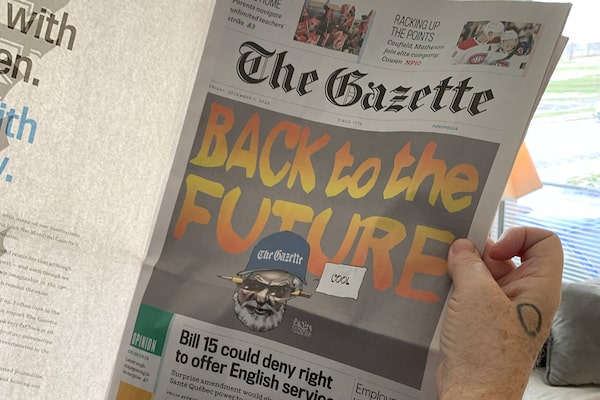
The Gazette is itself a leading institution of anglo Montreal and a recent 'new look' sent a signal to anglo readers that the paper still has their back.Marcus Gee/The Globe and Mail
The Montreal Gazette has a new look – or, rather, an old one. On Dec. 1, the venerable daily chucked the standardized front-page logo imposed by its corporate masters – “Montreal Gazette” inside a blue square – and reinstated its historic gothic nameplate.
Now, as before, it’s just The Gazette. “Back to the future,” announced a page-one illustration by its editorial cartoonist Terry Mosher, a fixture in the paper for half a century under the pen name Aislin.
It was a small gesture but, for anglophones and newspaper fans, a telling one. Daily papers are fighting for their survival across the country. Montreal’s English-speakers are feeling under siege.
Premier François Legault and his Coalition Avenir Québec government have outdone even the separatist Parti Québécois in their zeal to curtail the use of English and confirm the predominance of French. Just this fall, they took on two pillars of the English community, McGill and Concordia universities, by jacking up tuition fees for students who come to study in Quebec from other provinces, a move the universities’ leaders say will hobble them.
With the federal government hesitant to confront Mr. Legault on language issues, “there is a feeling that we’re on our own,” says Mr. Mosher. Anglos are feeling “insulted, really insulted.”
Bringing back the old logo is a way of showing that someone has their back. “I just wanted to find a way to cut through the noise and say, you know, we’re here for you, and we’re still fighting,” says Gazette editor-in-chief Lenie Lucci, who wrote a front-page note to readers trumpeting the change.
She says that for anglos these days, it just seems like one thing after the other. The way they see it, the CAQ is “systematically coming for English institutions.”
The Gazette is itself a leading institution of anglo Montreal. One of the oldest newspapers in North America, it was founded in 1778, making it considerably senior to the paper you are reading now. The Globe, forerunner of The Globe and Mail, started publishing only in 1844.
Fleury Mesplet, a French-born printer, freethinker and admirer of Voltaire, was The Gazette’s founder. According to a biographical sketch in The Gazette from 2017, he came to Montreal during the American Revolution. Benjamin Franklin summoned him there, printing press in tow, after the Americans captured the city. He hoped Mesplet would help turn Montrealers against the ruling British and convert them to the revolutionary cause.
The effort failed and the Americans left, but Mesplet stayed on to found La Gazette du Commerce et Littéraire pour la Ville et District de Montréal, the ancestor of today’s paper. It appeared first just in French, then in French and English and then, from 1822 on, in English alone.
It would go on to become one of the leading papers in what was until the 1970s Canada’s biggest city. During its fat years, it was a must-read for English-speakers, the home of columnists such as Nick Auf der Maur, contributors such as Mordecai Richler and the perennial Mr. Mosher, now 81.
As the English ascendancy waned and Quebec nationalism waxed, other English-language dailies dropped by the wayside one by one: The Montreal Herald in 1957; the Montreal Star in 1979; and the Montreal Daily News in 1989.
The Gazette is the last one standing, and it’s a shadow of its old self. Twenty years ago, it had 175 people in its newsroom. Now it’s down to around 30.
Like most newspapers, it has seen its advertising revenue drain away to giant online platforms, its print version grow gaunt and its readership age and shrink. Its owners at Postmedia, the national chain majority-owned by a New Jersey hedge fund, have imposed round after round of job and spending cuts on its papers.
After an outcry in Montreal over the latest round at the start of 2023, Postmedia named an 11-member advisory council made up of business and community leaders to work on ensuring the paper’s survival.
Ms. Lucci wants to reach out to a new generation of English-speaking, often fluently bilingual Quebeckers who would like to stay in the new Quebec. The daughter of an Italian father and Portuguese mother, she speaks five languages herself. “I’m so tired of waving goodbye to my friends moving to Toronto because they get better jobs,” she says.
Whether she can succeed, or whether this is the closing chapter in The Gazette’s 2½-century story, is an open question, but she is determined to show the paper is not done just yet.
Ms. Lucci says that in an era of polarization and misinformation, it is more important than ever for Montreal to have a reliable source of news, something beyond a TikTok video or Instagram post. “The only way to fight bad information is with good information,” she says. To her, the old logo with its classic typeface harkens back to an era of trust.
Quite obviously, disinterring the old Gazette logo won’t save the paper, or rescue the newspaper industry or stop young anglos from leaving Quebec. But it does seem to have given Gazette people something they were craving: a little hope. Readers have been writing to congratulate the paper on the change. Staff have been proudly wearing ball caps with the revived logo on the brow.
“People are talking about The Gazette again,” says Mr. Mosher. When readers saw the old logo – “not this goddamn square thing invented by some 18-year-old designer in Toronto” – he says “it did their hearts good.” To the cartoonist, a hardcore baseball fan, it was “almost like the Expos coming back.”
Even the mayor of Montreal, Valérie Plante, hailed the return of The Gazette’s “légendaire logo original.” Posting a picture of a Gazette cap on Instagram, she said “bravo!”
 Marcus Gee
Marcus Gee